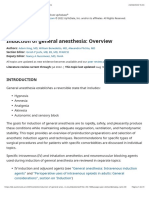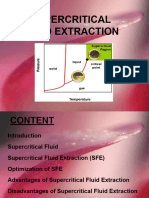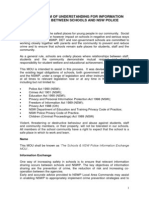Module 10
Uploaded by
Syafri LushainiModule 10
Uploaded by
Syafri LushainiNPTEL Novel Separation Processes
Module : 10 Supercritical Fluid Extraction
Dr. Sirshendu De
Professor, Department of Chemical Engineering Indian Institute of Technology, Kharagpur e-mail: sde@che.iitkgp.ernet.in
Keywords:
Separation processes, membranes, electric field assisted separation, liquid membrane, cloud point extraction, electrophoretic separation, supercritical fluid extraction
Joint Initiative of IITs and IISc - Funded by MHRD
Page 1 of 11
NPTEL Novel Separation Processes
Supercritical Fluid Extraction Critical Condition:
At a certain temperature and pressure condition (critical condition), liquid and vapor phases of a substance become indistinguishable. A substance whose temperature and pressure are higher than its critical point is known as supercritical fluid (SCF). Fig. 10.1 shows typical pressure temperature history of a substance.
Liquid Pressure Solid
Supercritical regime
Vapour
Temperature Fig. 10.1: Typical pressure temperature history of a substance Physical and thermal properties of SCFs are in between pure liquid and gas. Changes in properties are for a SCF are as follows: (i) (ii) (iii) (iv) (v) Liquid like densities Reduction in surface tension Gas like viscosity Gas like compressibility properties Diffusivities higher than liquids
Joint Initiative of IITs and IISc - Funded by MHRD
Page 2 of 11
NPTEL Novel Separation Processes
Commonly used supercritical (SC) solvents:
Some commonly used supercritical solvents are carbon di oxide, nitrous oxide, ethylene, propylene, propane, n-heptane, ethanol and ammonia. Among these, CO2 is widely used as a supercritical solvent. Substance Tc (0K) Pc (atm) Density (g/cc) CO2 Ethane Ethanol Propane 304.2 305.5 516.6 370.3 73 48.2 63.0 42.0 0.47 0.20 0.28 0.22
Why CO2 is a supercritical fluid (SCF)?
Following properties of CO2 make it qualified to be an SCF. (i) (ii) (iii) (iv) (v) (vi) (vii) Low critical pressure (74 atm) and low critical temperature (320C) Relatively non-toxic Non-flammable Available as high purity Low cost Easily removable from extract It has polarity like liquid pentane at supercritical conditions and thus, best suited for liophilic compounds.
Drawback: It cannot extract polar solutes.
Joint Initiative of IITs and IISc - Funded by MHRD
Page 3 of 11
NPTEL Novel Separation Processes
Nitrous Oxide:
It is good for removal or solubilize polar solutes, as it has a permanent dipole moment. N2O is better than CO2 for extraction of polychlorinated dibenzodioxines from fly ash. Disadvantage: It is highly explosive
H2O:
Disadvantage: (i) (ii) High Pc and Tc (Tc > 3740C, Pc > 221 bar) At these conditions, H2O is corrosive.
Important parameters for SCF extraction:
(i) Threshold pressure: Pressure at which miscibility of solute starts. Fig. 10.2 shows typical solubility curve of a material at a particular temperature.
Solubility (g/l)
T = 450C for CO2 Threshold Pressure
Pressure Fig. 10.2: Typical solubility curve of a material at a particular temperature. (ii) (iii) Pressure at which solute reaches its maximum solubility. Knowledge of physical properties of solutes (particularly, melting points). Solutes are dissolved better in liquid state.
Joint Initiative of IITs and IISc - Funded by MHRD
Page 4 of 11
NPTEL Novel Separation Processes
Co-solvents or Modifiers:
Co-solvents are added to modify the polarity of the SCF, so that the power of SCF to solvate polar solutes increases. Ex: CO2 should be mixed with 1-10% of methanol to solubilize more polar solutes.
Advantages of SCF extraction:
(i) Simple expansion of SCF leads to lowering in solubility capacity of it. Thus, dissolved solutes are separated. (ii) They have liquid like density but superior mass transfer behaviour compared to liquids due to high diffusivity and low surface tension so that they can penetrate into the porous structure of solid matrix to release the solute.
Mechanism of solubilization of solutes from solid materials:
There exists four mechanisms for solubilization of solutes in SCF: (i) If there is no interaction between solute and solid phase, the process is dissolution of solute in suitable solvent. (ii) If there is interaction between solute and solid, extraction is desorption. Adsorption isotherm of solute on the solid in presence of solvent determines the equilibrium. (iii) Swelling of solid phase by the solvent accompanied by extraction of entrapped solutes through the first two mechanisms. (iv) Reactive extraction.
Joint Initiative of IITs and IISc - Funded by MHRD
Page 5 of 11
NPTEL Novel Separation Processes
Insoluble solutes react with solvent and products are soluble and hence extractable. For example, lignin extraction from cellulose.
Thermodynamic Parameters:
Temperature, pressure, adsorption equilibrium constant and solubility of solute in solvent are the major thermodynamic properties in this regard.
Basic Techniques in SCF technology:
1. RESS (Rapid expansion of supercritical solutions): A typical flow chart of a supercritical fluid extraction process is outlined in Fig. 10.3. A supercritical solvent saturated with a solute is allowed to expand rapidly, leading to precipitation of solute. Rapid expansion is achieved by allowing it to pass through a nozzle at supersonic speed.
Pressure regulator
Fluid Reservoir
Preheater
Pump Valv
Heating region Collection surface Collection chamber Expansion nozzle
Fig. 10.3: A typical flow sheet of a SCF process
Joint Initiative of IITs and IISc - Funded by MHRD
Page 6 of 11
NPTEL Novel Separation Processes
Supercritical fluid (SF) is pumped through a pre heater into the vessel containing solid solute and the resultant solution is sent into a precipitation chamber by expansion through capillary or laser drilled nozzle. At precipitation chamber, pressure is much lower and solute solubility in SF is quite low and solute precipitates out of it. Size distribution and morphology of precipitated material is a function of pre-expansion concentration and its conditions. Pre-expansion concentration in term depends on SF, nature of solute, addition of co-solvent, operating pressure and temperature. Particle size is smaller and distribution is narrower if pre-expansion concentration is higher. Example: Naphthalene extraction process A typical naphthalene extractor is shown in Fig. 10.4.
Pressure reduction valve
Extraction Vessel
Separator
Compressor
Fig. 10.4: A typical naphthalene extractor
The solubility diagram of naphthalene is shown in Fig. 10.5.
Joint Initiative of IITs and IISc - Funded by MHRD
Page 7 of 11
NPTEL Novel Separation Processes
15% 15 300 bar
Concentration of naphthalene 1.0 (wt%) log scale 70 bar 20 30 40
0
120 bar
90 bar
Temperature ( C)
Fig. 10.5: Solubility diagram of naphthalene under supercritical condition
A naphthalene-chalk dust mixture is fed to the extraction vessel. Assume, extraction condition is 300 bar and 550C. At this condition CO2 SCF contains naphthalene dissolved at 15 wt%. Then it is expanded to 90 bar through pressure reduction valve (assuming isenthalpic expansion). After expansion its temperature is 360C at 90 bar. Solubility of naphthalene is 2.5%. So, it falls out of solution. Precipitated naphthalene is collected and CO2 is compressed to 550C and 300 bar and recycled to extractor.
Joint Initiative of IITs and IISc - Funded by MHRD
Page 8 of 11
NPTEL Novel Separation Processes
Mollier Diagram:
P = 600 bar
800C 720C
Enthalpy (Kcal/Kg) 155 152 145 135
2 1
300 bar
200 bar 90 bar
Temperature
600C 550C 400C 360C 200C
0.6
0.7
0.8
0.9
1.0
(1) 550C, 300 bar (2) 360C, 90 bar (after expansion) (3) 720C, 300 bar (after compression) Energy required to compress from 90 to 300 bar is,
(152 145) = 7 Kcal/kg
Then it is cooled to 550C
(12.6 BTU/lb)
(4) 720C, 300 bar to 550C, 300 bar Decrease in solubility is 15 to 2.5 wt%
1 lb CO2 contains 0.15 lb Naphthalene
After extraction
1 lb CO2 contains 0.025 lb Naphthalene
Extracted naphthalene = 0.15 0.025 = 0.125 lb
Joint Initiative of IITs and IISc - Funded by MHRD Page 9 of 11
NPTEL Novel Separation Processes
0.125 lb naphthalene extracted for 1lb CO2
So,
0.125 lb naphthalene extracted for =
1000 = 8 lb CO 2 125
So, we require 8 lb CO2 to recycle for extraction of 1 lb naphthalene. Energy required for compression from 90 to 300 bar is = 12.6 8 BTU
= 100.8 BTU for extraction of 1 lb naphthalene
Some Special Applications of supercritical fluid extraction:
1. Removal of fat from foods 2. Extraction of vitamin E from natural resources 3. Removal of alcohol from wine and beer 4. Extraction of pesticides 5. Extraction of polyaromatic hydrocarbon, polychloro benzene
References:
1. K. A. Abbas, A. Mohamed, A. S. Abdulamir, and H. A. Abas, A Review on Supercritical Fluid Extraction as New Analytical Method, American Journal of Biochemistry and Biotechnology, 4 (4) (2008) 345-353. 2. M. Zougagh, M. Valcarcel and A. Rios, Supercritical Fluid Extraction: A Critical Review of its Analytical Usefulness, Trends in Analytical Chemistry, 25 (2004) 399-405. 3. I. J. Barnabas and J. R. Dean, Supercritical Fluid Extraction of Analytes from Environmental Samples, Analyst, 119 (1994) 2381-2394.
Joint Initiative of IITs and IISc - Funded by MHRD
Page 10 of 11
NPTEL Novel Separation Processes
4. K. K Darani and E. V. Farahani, Application of supercritical fluid extraction in biotechnology, Critical Reviews in Biotechnology, 25 (2005) 231-242. 5. S. M. Pourmortazavi and S. S. Hajimirsadeghi, Supercritical fluid extraction in plant essential and volatile oil a, Journal of Chromatography A, 1163 (2007) 1-24.
Joint Initiative of IITs and IISc - Funded by MHRD
Page 11 of 11
You might also like
- Advanced Logic Synthesis: Multiple Choice QuestionsNo ratings yetAdvanced Logic Synthesis: Multiple Choice Questions16 pages
- Induction of General Anesthesia: Overview - UpToDate100% (1)Induction of General Anesthesia: Overview - UpToDate41 pages
- Pressurized Fluid Extractions: Factors Affecting An Extraction ProcessNo ratings yetPressurized Fluid Extractions: Factors Affecting An Extraction Process21 pages
- Transport Phenomena Supercritical ExtractionNo ratings yetTransport Phenomena Supercritical Extraction30 pages
- Supercritical Fluid Extraction: by Nicole Adams and Morgan CampbellNo ratings yetSupercritical Fluid Extraction: by Nicole Adams and Morgan Campbell27 pages
- Supercritical Fluids Supercritical Fluid Extraction : SCF SFENo ratings yetSupercritical Fluids Supercritical Fluid Extraction : SCF SFE11 pages
- Supercritical Solvent Extraction LectureNo ratings yetSupercritical Solvent Extraction Lecture16 pages
- Extracted_Utilization of Marine Bioactive Compounds - Research Advances and Future Trends-8-114!14!22No ratings yetExtracted_Utilization of Marine Bioactive Compounds - Research Advances and Future Trends-8-114!14!229 pages
- Supercritical Fluid Extraction: - A ReviewNo ratings yetSupercritical Fluid Extraction: - A Review15 pages
- Supercritical Nitrogen Processing For The Purification of Reactive Porous MaterialsNo ratings yetSupercritical Nitrogen Processing For The Purification of Reactive Porous Materials11 pages
- Supercritical Fluid Supercritical Fluid Extraction (Sfe) Supercritical Fluid Chromatography (SFC)No ratings yetSupercritical Fluid Supercritical Fluid Extraction (Sfe) Supercritical Fluid Chromatography (SFC)67 pages
- Supercritical Direct Extraction of Neodymium Using Tta and TBPNo ratings yetSupercritical Direct Extraction of Neodymium Using Tta and TBP11 pages
- Super Critical Fluid Chromatography: by K.Prabhavthi Regd No.10021d7612 Pharmacology JNTU, KakinadaNo ratings yetSuper Critical Fluid Chromatography: by K.Prabhavthi Regd No.10021d7612 Pharmacology JNTU, Kakinada19 pages
- What Is A Supercritical Fluid ?: Author: Michel PERRUT - SEPAREX 1. DefinitionNo ratings yetWhat Is A Supercritical Fluid ?: Author: Michel PERRUT - SEPAREX 1. Definition6 pages
- 9.EFSC - Desde - Matrices - Sólidas - Formulación - Del Modelo - 2003No ratings yet9.EFSC - Desde - Matrices - Sólidas - Formulación - Del Modelo - 20035 pages
- T: Q I A C: Opic Uality N Nalytical HemistryNo ratings yetT: Q I A C: Opic Uality N Nalytical Hemistry13 pages
- Nlewis65,+96 101 Laboratory Gabbard 35 No 2 SPRING 2001 CEENo ratings yetNlewis65,+96 101 Laboratory Gabbard 35 No 2 SPRING 2001 CEE6 pages
- Supercritical Fluid Extraction From Vegetable Materials - SovovaNo ratings yetSupercritical Fluid Extraction From Vegetable Materials - Sovova78 pages
- Supercritical Fluid Extraction From Vegetable MaterialsNo ratings yetSupercritical Fluid Extraction From Vegetable Materials78 pages
- We Are Intechopen, The World'S Leading Publisher of Open Access Books Built by Scientists, For ScientistsNo ratings yetWe Are Intechopen, The World'S Leading Publisher of Open Access Books Built by Scientists, For Scientists31 pages
- Bioprocessing for Cell-Based TherapiesFrom EverandBioprocessing for Cell-Based TherapiesChe J. ConnonNo ratings yet
- How To Calculate Notice Timedkading Master For Stopping The Cargo... Here Is The Answer - MySeaTimeNo ratings yetHow To Calculate Notice Timedkading Master For Stopping The Cargo... Here Is The Answer - MySeaTime4 pages
- IAC 16 - Regulatory Framework For Business TransactionsNo ratings yetIAC 16 - Regulatory Framework For Business Transactions13 pages
- Bharti Airtel Limited Performance AppraisalNo ratings yetBharti Airtel Limited Performance Appraisal13 pages
- Instant ebooks textbook Financial Sector Development in Ghana: Exploring Bank Stability, Financing Models, and Development Challenges for Sustainable Financial Markets James Atta Peprah download all chapters100% (4)Instant ebooks textbook Financial Sector Development in Ghana: Exploring Bank Stability, Financing Models, and Development Challenges for Sustainable Financial Markets James Atta Peprah download all chapters76 pages
- Title: Tilt Cylinder Model Number: 863 Serial Number: 514440001 & Above, 514540001 & Above, 514640001 & AboveNo ratings yetTitle: Tilt Cylinder Model Number: 863 Serial Number: 514440001 & Above, 514540001 & Above, 514640001 & Above3 pages
- HSE - Statistics - Report - Name ContractorNo ratings yetHSE - Statistics - Report - Name Contractor4 pages
- Advanced Logic Synthesis: Multiple Choice QuestionsAdvanced Logic Synthesis: Multiple Choice Questions
- Induction of General Anesthesia: Overview - UpToDateInduction of General Anesthesia: Overview - UpToDate
- Pressurized Fluid Extractions: Factors Affecting An Extraction ProcessPressurized Fluid Extractions: Factors Affecting An Extraction Process
- Supercritical Fluid Extraction: by Nicole Adams and Morgan CampbellSupercritical Fluid Extraction: by Nicole Adams and Morgan Campbell
- Supercritical Fluids Supercritical Fluid Extraction : SCF SFESupercritical Fluids Supercritical Fluid Extraction : SCF SFE
- Extracted_Utilization of Marine Bioactive Compounds - Research Advances and Future Trends-8-114!14!22Extracted_Utilization of Marine Bioactive Compounds - Research Advances and Future Trends-8-114!14!22
- Supercritical Nitrogen Processing For The Purification of Reactive Porous MaterialsSupercritical Nitrogen Processing For The Purification of Reactive Porous Materials
- Supercritical Fluid Supercritical Fluid Extraction (Sfe) Supercritical Fluid Chromatography (SFC)Supercritical Fluid Supercritical Fluid Extraction (Sfe) Supercritical Fluid Chromatography (SFC)
- Supercritical Direct Extraction of Neodymium Using Tta and TBPSupercritical Direct Extraction of Neodymium Using Tta and TBP
- Super Critical Fluid Chromatography: by K.Prabhavthi Regd No.10021d7612 Pharmacology JNTU, KakinadaSuper Critical Fluid Chromatography: by K.Prabhavthi Regd No.10021d7612 Pharmacology JNTU, Kakinada
- What Is A Supercritical Fluid ?: Author: Michel PERRUT - SEPAREX 1. DefinitionWhat Is A Supercritical Fluid ?: Author: Michel PERRUT - SEPAREX 1. Definition
- 9.EFSC - Desde - Matrices - Sólidas - Formulación - Del Modelo - 20039.EFSC - Desde - Matrices - Sólidas - Formulación - Del Modelo - 2003
- Nlewis65,+96 101 Laboratory Gabbard 35 No 2 SPRING 2001 CEENlewis65,+96 101 Laboratory Gabbard 35 No 2 SPRING 2001 CEE
- Supercritical Fluid Extraction From Vegetable Materials - SovovaSupercritical Fluid Extraction From Vegetable Materials - Sovova
- Supercritical Fluid Extraction From Vegetable MaterialsSupercritical Fluid Extraction From Vegetable Materials
- We Are Intechopen, The World'S Leading Publisher of Open Access Books Built by Scientists, For ScientistsWe Are Intechopen, The World'S Leading Publisher of Open Access Books Built by Scientists, For Scientists
- How To Calculate Notice Timedkading Master For Stopping The Cargo... Here Is The Answer - MySeaTimeHow To Calculate Notice Timedkading Master For Stopping The Cargo... Here Is The Answer - MySeaTime
- IAC 16 - Regulatory Framework For Business TransactionsIAC 16 - Regulatory Framework For Business Transactions
- Instant ebooks textbook Financial Sector Development in Ghana: Exploring Bank Stability, Financing Models, and Development Challenges for Sustainable Financial Markets James Atta Peprah download all chaptersInstant ebooks textbook Financial Sector Development in Ghana: Exploring Bank Stability, Financing Models, and Development Challenges for Sustainable Financial Markets James Atta Peprah download all chapters
- Title: Tilt Cylinder Model Number: 863 Serial Number: 514440001 & Above, 514540001 & Above, 514640001 & AboveTitle: Tilt Cylinder Model Number: 863 Serial Number: 514440001 & Above, 514540001 & Above, 514640001 & Above

























































































